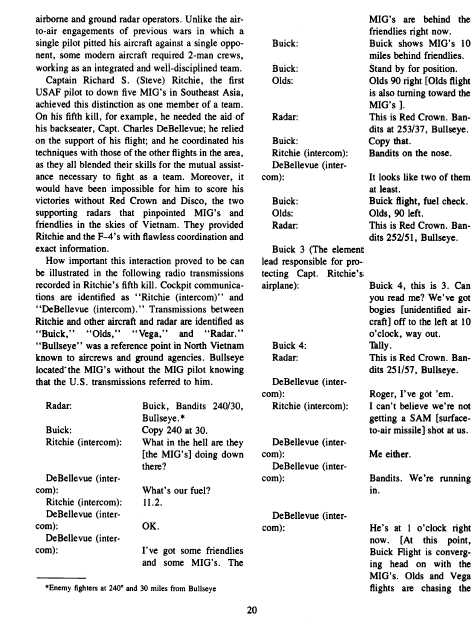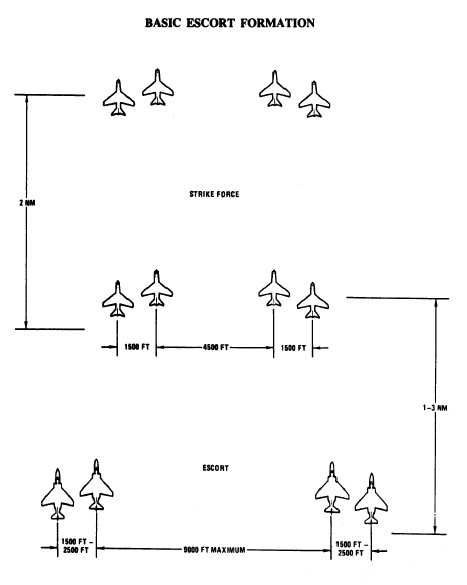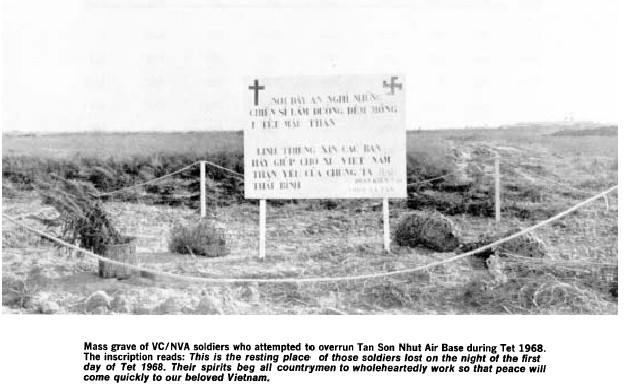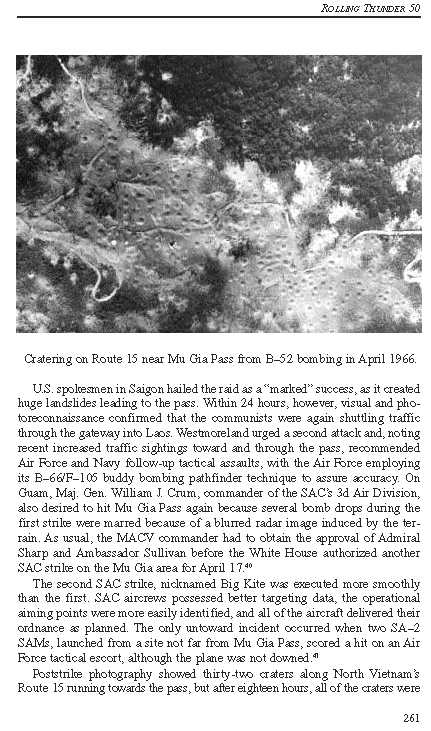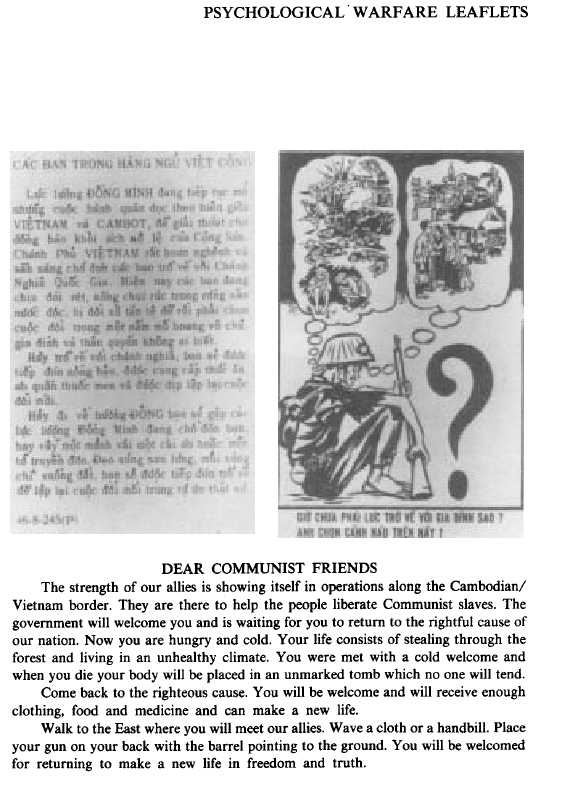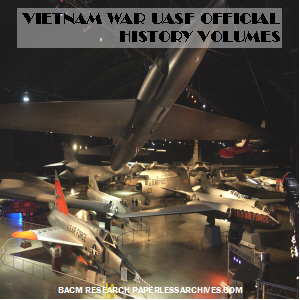|
Some of these titles were produced from formally classified manuscripts. Official history compiled by United States Air Force historians. Some of these volumes can be difficult to find, because they were printed in limited quantities, and intended for a specialized audience. Maps, charts, and photos are used to help document the United States Air Force's role in the Vietnam War.
Among the volumes:
THE UNITED STATES AIR FORCE IN SOUTHEAST ASIA; ACES AND AERIAL VICTORIES, 1965-1973.
Aces and Aerial Victories is a collection of firsthand accounts by Air Force fighter crews who flew combat missions over North Vietnam between 1965 and 1973. They recall their air battles with MIG fighters, the difficult and dangerous tactical maneuvers they had to perform to survive, and their victories and defeats. The narratives are taken directly from aircrew after-action reports. A number of direct quotations have been altered, but only to clarify for the reader the very specialized language of their profession (e.g., code words).
"During the war in Southeast Asia, U.S. Air Force fighter pilots and crewmen were repeatedly challenged by enemy MIG's in the skies over North Vietnam. The air battles which ensued were unique in American history because U.S. fighter and strike forces operated under stringent rules of engagement. With periodic exceptions, for example, MIG bases could not be struck. The rules generally forbade bombing or strafing of military and industrial targets in and around the enemy's heartland, encompassing the capital of Hanoi and the port city of Haiphong. These restrictions gave the North Vietnamese substantial military advantage. Free from American attack and helped by its Soviet and Chinese allies, the enemy was able to construct one of the most formidable anti-aircraft defenses the world has even seen. It included MIG forces, surface-to-air missile (SAM) batteries, heavy concentrations of antiaircraft artillery (AAA) units, and an array of early warning radar systems. These elements sought to interdict and defeat the U.S. bombing campaign against North Vietnam's lines of communication and its military and industrial base. The primary mission of U.S. fighter pilots was to prevent the North Vietnamese MIG's from interfering with U.S. strike operations. This book tells how American airmen-assisted by an armada of other USAF aircraft whose crews refueled their planes, warned of approaching enemy MIG's and SAM'S, and flew rescue missions when they were shot down, managed to emerge from their aerial battles with both victories and honor." - JOHN W. HUSTON, Major General, USAF Office of Air Force History
THE UNITED STATES AIR FORCE IN SOUTHEAST ASIA: THE ADVISORY YEARS TO 1965
This volume tells the story of the Air Force's involvement in the region from the end of the second World War, until the major infusion of American troops into Vietnam in 1965. During these years, and most noticeably after 1961, the Air Force's principal role in Southeast Asia was to advise the Vietnamese Air Force in its struggle against insurgents seeking the collapse of the Saigon government. This story includes some issues of universal applicability to the Air Force: the role of air power in an insurgency, the most effective way to advise a foreign ally, and how to coordinate with other American agencies (both military and civilian) which are doing the same thing. It also deals with issues unique to the Vietnamese conflict: how to coordinate a centralized, technological modern airforce with a feudal, decentralized, indigenous one without overwhelming it, and how best to adapt fighter, reconnaissance, airlift, and liaison planes to a jungle environment.
USAF SOUTHEAST ASIA MONOGRAPH SERIES VOLUME VII: AIR FORCE HEROES IN VIETNAM.
This volume tells the story of 12 airmen who were awarded the Congressional medal of honor. Three of the men died in action for which he were cited.
AIR BASE DEFENSE IN THE REPUBLIC OF VIETNAM 1961 - 1973
This volume explores the unique problem of defending air bases during the Vietnam War. It centers on the primary efforts of the United States Air Force and allied air units to defend 10 key air bases within the Republic of Vietnam. Bien Hoa, on 1 November 1964, was the first base to be attacked and until the cease-fire in January 1973, these bases suffered a total of 475 attacks. Although there were initial deficiencies in staff support for base defense in such key areas as intelligence, motor vehicles, weapons procurement and maintenance, communications, and civil engineering, significant improvements had been made by the end of the Air Force's part in the Vietnam War.
The author, Lt. Col. Roger P. Fox, USAF (Ret.), wrote this volume while assigned to the Office of Air Force History. He brings judgments to his research based on his personal experience as a base security officer during the conflict. Thus, early on the morning of 4 December 1966, he rallied Air Force and South Vietnamese security forces to repel an enemy attempt to penetrate Tan Son Nhut Air Base, the center of Air Force operations in South Vietnam. For his gallantry in action on this occasion, he was awarded the Silver Star. This personal experience formed a foundation upon which he developed a keen insight into exploring the entire spectrum of air base defense, and upon which he has built a strong case for testing future plans and operations.
THE UNITED STATES AIR FORCE IN SOUTHEAST ASIA: CIVIC ACTION
Capt. Betty L. Barton Christiansen, a member of the staff in the Office of Air Force History, researched and wrote this volume. She begins by establishing a framework of the civic action concept. Chapter II discusses the period corresponding to the Kennedy administration, when both government and military officials grappled with adjusting to a "new kind of war," the origins of counterinsurgency strategy (of which civic action was a part), and the efforts to apply this strategy in Vietnam. The nation-building period discussed in Chapter III, covers the period from November 1963 to July 1965, a time of great instability in South Vietnam, and the myriad efforts by the USAF to establish unity. Although he had promised to continue the policies of President Kennedy, Lyndon Johnson began to "lean away" from political and other non-military solutions to the crisis in Vietnam. This was reflected in the attitudes of the various services toward unconventional warfare and civic action. By 1966, while military solutions occupied center stage, some stability had been established in Vietnam. More attention was being paid to winning popular allegiance and USAF's Seventh Air Force formally organized its civic action activities. However, just as the program showed signs of success, the Tet offensive intervened. Thus, Chapter V demonstrates that instead of serving as advisers to the Vietnamese, the USAF civic action effort was compelled to revert to an earlier phase of its development, when humanitarian services were emphasized. Still, the program recuperated completely by July 1968. In Chapter VI, the South Vietnamese government embarked on an accelerated pacification program to extend its control throughout the country. Civic action constituted one part of this effort. Seventh Air Force sought to improve training civic action personnel, increase the number of civic action officers "in country," and obtain more resources for the program. These refinements provided a better understanding of civic action and showed the benefits of increased South Vietnamese participation. By the end of 1968, pacification had become a major part of allied strategy in Vietnam. The results of the various changes in the civic action program are discussed and assessed.
AIRPOWER AND THE AIRLIFT EVACUATION OF KHAM DUC
This narrative describes the evacuation of more than 1,400 American soldiers, Marines, and airmen, and Vietnamese men, women, and children from the Kham Duc Special Forces camp in southern I Corps on 12 May 1968. It treats the geographical and topographical setting, the threat to the camp posed by two regiments of the North Vietnamese Army, and the danger to the camp and its inhabitants from the communist seizure of all the high ground around the camp. The monograph devotes individual chapters to the US Army and Marine helicopter rescue efforts, tactical air support, and tactical airlift. The final chapter deals with the attempts to rescue the last three men at Kham Duc. American aircraft losses were severe during the evacuation, and the successful outcome of the mass rescue depended upon the skill and courage of American aircrews. The author, Lieutenant Colonel Alan L. Gropman, concludes that had command and control been better, losses probably would have been less severe.
This volume has value for both the general reader and the aviation specialist. For the latter there are lessons regarding command and control and combined-unit operations that need to be learned to achieve battlefield success. For the former there is a straightforward narrative about American aviators of all four services struggling in the most difficult of conditions to try to rescue more than 1,500 American and Vietnamese military and civilians. Not all the Americans moving through the events recounted in this monograph acted heroically, but most did, and it was their heroism that gave the evacuation the success it had. Airpower and the Airlift Evacuation of Kham Duc is fully documented so that readers wishing to look deeper into this incident may do so. Those who study the battle will see that it was something of a microcosm of the entire Vietnam War in the relationship of airpower to tactical ground efforts. Kham Duc sat at the bottom of a small green mountain bowl, and during most of 12 May 1968 the sky was full of helicopters, forward air controller aircraft, transports, and fighters, all striving to succeed and to avoid running into each other in what were most trying circumstances. In the end they carried the day, though by the narrowest of margins and with heavy losses.
The author of this monograph, Lieutenant Colonel Alan L. Gropman, has been a long-time student of military history. His interest in the evacuation of Kham Duc was born of his many years as a C-130 navigator, the loss of several friends during the evacuation, and his long friendship with one of the last men rescued.
AIR POWER AND THE FIGHT FOR KHE SANH
The 1968 fight for Khe Sanh pitted some 6,000 U.S. Marines and South Vietnamese Rangers against an opposing force roughly three times as large. For more than 70 days North Vietnamese troops maintained pressure on Khe Sanh's defenders, who had dug in around the base's airstrip. The original purpose for deploying the Marines and South Vietnamese into the northwest corner of South Vietnam was to block Communist troop movements along Highway 9 toward Quang Tri City and the heavily populated coastal areas. When U.S. intelligence detected large enemy forces assembling near Khe Sanh, the senior American commander in Vietnam, General William C. Westmoreland, ordered the Marines to hold the base. General Westmoreland suspected that North Vietnam's Defense Minister, General Vo Nguyen Giap, might be tempted to mount a major attack against the base in hopes of achieving "a climactic victory, such as he had done in 1954 at Dien Bien Phu." If Giap did order such an attack, General Westmoreland believed it would provide U.S. air power "a singular opportunity" to destroy a massed enemy force in a relatively uninhabited, isolated region of South Vietnam. In late January 1968 General Westmoreland advised the Chairman of the Joint Chiefs of Staff in Washington, D.C., of his decision to defend Khe Sanh. The Chiefs backed him unanimously.
During the siege that followed, U.S. strike aircraft rained nearly 100,000 tons of munitions down upon the North Vietnamese while other planes, primarily U.S. Air Force transports, flew in essential supplies of food, ammunition, and other necessities to Khe Sanh's defenders. The Leathernecks also used their own aircraft to provision Marine outposts which denied the enemy the high ground overlooking the base. Other military elements participating in the battle included U.S. Army artillerymen dug in east of Khe Sanh, who fired deadly concentrations against the besieging forces. Marine howitzers and mortars added to the heavy U.S. fire, while Army engineers joined Navy Seabees in helping prepare airstrips which supported the allied defense effort. Finally, the relief of Khe Sanh, though spearheaded by Army troops, also involved American Marines and soldiers of the Army of the Republic of Vietnam.
In preparing this history, the author Bernard C. Nalty, has attempted to describe the essential contributions of the Army, Navy, and Marines as well as the Air Force. But primarily, he has concentrated upon the operations, activities, and accomplishments of the U.S. Air Force. He also has included in this narrative a discussion of several controversies and problem areas which arose during the battle, such as General Westmoreland's appointment of General William W. Momyer, his deputy for air, as single manager for air operations.
GRADUAL FAILURE THE AIR WAR OVER NORTH VIETNAM 1965�1966
"The United States Air Force reached its nadir during the opening two years of the Rolling Thunder air campaign in North Vietnam. Never had the Air Force operated with so many restraints and to so little effect. These pages are painful but necessary reading for all who care about the nation's military power. Jacob Van Staaveren wrote this book in the 1970's near the end of his distinguished government service, which began during the occupation of Japan; the University of Washington Press published his book on that experience in 1995. He was an Air Force historian in Korea during the Korean War, and he began to write about the Vietnam War while it was still being fought. His volume on the air war in Laos was declassified and published in 1993. Now this volume on the air war in North Vietnam has also been declassified and is being published for the first time. Although he retired to McMinnville, Oregon, a number of years ago, we asked him to review the manuscript and make any changes that seemed warranted. For the most part, this is the book he wrote soon after the Vietnam War. Readers of this volume will also want to read the sequel, Wayne Thompson's To Hanoi and Back: The U. S. Air Force and North Vietnam, 1966�1973, which tells the more encouraging story of how the Air Force employed airpower to far greater effect using a combination of better doctrine, tactics, technology, and training." - RICHARD P. HALLION, Air Force Historian
LAST FLIGHT FROM SAIGON
"Last Flight From Saigon" is an exciting and moving account of how all United States military services, as well as several civilian agencies, pulled together to pull-off the largest aerial evacuation in history, what many have referred to as a modern day Dunkirk. The three authors, intimately involved with the evacuation from beginning to end, have carefully pieced together an amazing story of courage, determination and ingenuity. Above all, it's a story about saving lives, one that is seldom told in times of war.
On the last two days in April 1975, Operation FREQUENT WIND, the evacuation of Vietnam, ended a twenty-year agony for the United States. A trial for America was done. The last 45 days of her presence in South Vietnam may seem almost insignificant compared to the previous decades of pain. But, in a continuous effort under ever-increasing pressure, the US Embassy in Saigon, and its Defense Attache Office (DAO) there, helped plan, prepare for, and ultimately conduct, the final evacuation from South Vietnam. Operation FREQUENT WIND extracted 130,000 people including: Vietnamese citizens, Third Country Nationals and US citizens.
Faced with hundreds of hard decisions, enormous logistical requirements, continuous security problems, and the threat of enemy military action, American civilians and military men conducted an efficient evacuation. Graham Martin, the last US Ambassador to South Vietnam, and the man in overall charge of the evacuation, said that in the long run the extraction at Saigon would surely be judged as "a hell of a good job." On the evening of 29 April 1975, USAF Lieutenant Colonels Arthur E. Laehr and John F. Hilgenberg jumped off CH-53 helicopters onto the deck of the USS Midway, lying 30 miles off the coast of South Vietnam near Vung Tau. For the first time in several weeks, each breathed a huge sigh of relief; for them, the evacuation of Saigon, FREQUENT WIND, was finally over.
Over 45 minutes earlier, both had embarked on separate CH-53s in the tennis court helicopter landing zone adjacent to the Defense Attache Office on Tan Son Nhut (TSN) Air Base. From the Defense Attache office building (formerly MACV Headquarters), huge clouds of black smoke could be seen rising from the impact of intermittent rocket, and artillery shells on the main air base-barely a quarter mile away. Several blocks to the east, a huge fireball erupted in the vicinity of the Pacific Architects and Engineers' warehouse, the building of a contractor who maintained the last of the US facilities in Vietnam. The blaze cast an eerie, flickering light on the whole area-where over 20 years of American effort was coming to an end.
In Nakhon Phanom (NKP) Thailand, 450 miles away, Air Force Lt Colonel Thomas G. Tobin, who was pulled from the Saigon office on 17 April to advise and coordinate planning and execution of the evacuation at the United States Support Advisory Group (USSAG-7th Air Force), wondered just what had happened to his friends. In the last hours, communications between Nakhon Phanom, Saigon, Hawaii, and Washington had been intermittent, and reports could not confirm just who or how many got out. In the days following the evacuation, the three officers met in Hawaii to help prepare the final assessment of the US effort in South Vietnam. They had time to reflect on why the Republic of Vietnam disintegrated, but also, on how the evacuation of Saigon succeeded, despite what appeared to be very difficult odds. Rejoined again at the Air War College in Alabama, the three officers decided to write the story of the last days of the Thieu regime and of the American evacuation. Their account of the air escape from the falling city is filled with examples of determination, fear, confusion, and, most significantly, the professionalism of those who participated.
LINEBACKER II: A VIEW FROM THE ROCK
This monograph tells part of the story of Strategic Air Command's participation in LINEBACKER II. In so doing, it addresses the efforts of a complex mixture of Air Force and sister service operations, with all services working in concert towards a common goal. Rather than develop a complete chronology or blow-by-blow account, which are matters of record in other works, the campaign is pursued more from the personal perspective. Described is the impact of LINEBACKER II on those in command, plus those in operations, maintenance and support who undergirded the effort, and the crewmembers.
Operation Linebacker II operations were initiated on 18 December 1972. The narrative tells how they successfully met a staggering challenge. There was no book to follow. In only eleven days of intense combat operations they wrote their own book as they supported and flew the missions. That book revealed an across-the-board ability to radically change complex procedures and tactics on short notice, and a commensurate ability of aircrew and support personnel to execute them to near perfection.
The primary objective of the bombing operation would be to force the North Vietnamese government to enter into purposeful negotiations concerning a cease-fire agreement. The operation employed air power to its maximum capabilities in an attempt to destroy all major target complexes such as radio stations, railroads, power plants, and airfields located in the Hanoi and Haiphong areas. Unlike previous bombing campaigns, Linebacker II provided the Air Force and U.S. Naval forces with specific objectives and removed many of the restrictions that had previously caused frustration within the Pentagon.
During these operations, Air Force and Navy tactical aircraft and B-52s commenced an around-the-clock bombardment of the North Vietnamese heartland. The B-52s struck Hanoi and Haiphong during hours of darkness with F-111s and Navy tactical aircraft providing diversionary/suppression strikes on airfields and surface-to-air missile sites. Daylight operations were primarily carried out by A-7s and F-4s bombing visually or with long-range navigation (LORAN) techniques, depending upon the weather over the targets. In addition, escort aircraft such as the Air Force EB-66s and Navy EA-6s broadcast electronic jamming signals to confuse the radar-controlled defenses of the North. The Strategic Air Command also provided KC-135s to support the in-flight refueling requirements of the various aircraft participating in Linebacker II operations. The impact of the bombing was obvious in the severe damage to the North Vietnamese logistic and war-support capability. By 29 December 1972, the 700 nighttime sorties flown by B-52s and 650 daytime strikes by fighter and attack aircraft persuaded the North Vietnamese government to return to the conference table.
AIRPOWER AND THE 1972 SPRING INVASION
This volume recounts the myriad of widely separate, but not unrelated events and operations that took place during the spring invasion of 1972. In this monograph, the authors from the Air War College present an illuminating story of the people and machines that fought during this major offensive. The authors' breadth of experience in and out of combat enables them to provide a penetrating account of how airpower was brought to bear.
The "Vietnamization" program, begun in 1969, had by March of 1972 reduced U.S. manpower involvement in Vietnam from 500,000 to 95,000. U.S. airpower involvement, however, did not decrease proportionately. Although the South Vietnamese Air Force took up the "lion's share" of the effort, U.S. airmen were still very much involved.
By March 1972 the Vietnam War was ominously quiet after years of turbulence. War-weary citizens of the South Vietnamese republic looked to the future with hope. Since 1968, Allied programs of "pacification" had taken root, and now seemed to promise security and economic recovery for the yet impoverished countryside. Improved South Vietnamese armed forces, backed by the citizen Regional and Popular Forces, appeared capable of containing the Communist threat. The Communist cause seemed in decline, although guerrillas still harassed the populace in some locales, and North Vietnamese regiments remained active in border and remote areas.
From the Communist view, the logic of a bold strike in 1972 was compelling. Battlefield victories on several fronts, at the least, could make wreckage of Nixon's past policies and the public support upon which they rested. And there remained the further hope that initial successes could produce a fast deterioration of South Vietnamese will and ability to resist. The apparent architect of the 1972 Spring Offensive was General Vo Nguyen Giap, Defense Minister of the DRV. Giap had been an early associate of Ho Chi Minh and had directed the victory over the French at Dien Bien Phu. In 1968, he planned the countrywide Tet Offensive and the extended siege at Khe Sanh, the US. Marine base at the northwest corner of South Vietnam. The Allies defeated the Communists in 1968, largely through the heavy application of U.S. airpower. Now, in 1972, Giap again bid for victory, gambling the full strength of the North Vietnamese Army and its weaponry built up over the years at heavy cost.
THE UNITED STATES AIR FORCE IN SOUTHEAST ASIA: TACTICAL AIRLIFT
Throughout the Vietnam War, in Southeast Asia, American and Vietnamese forces relied heavily on tactical airlift to satisfy the logistical demands of the conflict. While doctrine normally dictated the use of railroads and roads first to move supplies, there was simply no way other than aircraft to move quickly the necessary volume of men and materiel over difficult terrain that was subject to frequent interdiction by the enemy. Tactical airlift had to support simultaneously the full range of U.S. and Vietnamese activities: irregular forces, covert operations, remote outposts, and fullscale conventional operations involving thousands of men. And the support had to be provided despite shortages of aircraft and crews, bureaucratic inefficiency, and chronic scheduling problems.
In total tonnage moved, Air Force tactical airlift in Southeast Asia very quickly exceeded previous efforts in the China-Burma-India theater in World War II, the Berlin Airlift, or the Korean War. Tactical airlift matured in Vietnam. American airlift personnel worked with the French prior to their pull-out in the mid-l950s, and started assisting South Vietnamese in the years just prior to the massive American involvement. Tactics were developed, and then changed constantly in an effort to adapt to current military situations. Sometimes the old procedures did not apply. For example, the dropping of paratroops, long a staple of tactical airlift, was only marginally successful and in 1966 was largely abandoned in favor of helicopter-borne assault forces. But the early involvement in airborne assault did provide experience in supporting a seemingly endless variety of missions and helped shape the future of the airlift mission.
The Author Ray Bowers wrote this history during 1969-1977 while assigned to the Office of Air Force History, Washington, D.C., where he served as supervisory historian of the Special Histories Branch.
THE UNITED STATES AIR FORCE IN SOUTHEAST ASIA: THE WAR IN SOUTH VIETNAM THE YEARS OF THE OFFENSIVE 1965-1968
This volume looks at the Air Force's support of the ground war in South Vietnam between 1965 and early 1968. It covers the period from the time when the United States began moving from an advisory role into one of active involvement to just before the time when the United States gradually began disengaging from the Vietnam War. The final scene is the successful air campaign conducted during the Communists' siege of the Marine camp at Khe Sanh. While the actual siege lasted from late January to the middle of March 1968, enemy preparations for the encirclement-greatly increased truck traffic and enemy troop movements, were seen as early as October 1967.
Air Force assistance in South Vietnam during the Vietnam War was principally of two kinds: close air support of troops on the battlefield, by both tactical fighters and B-52s, and the airlift of supplies and personnel. In addition to close air support and airlift, the Air Force performed many other important missions ancillary to the ground war, including reconnaissance, intelligence, psychological warfare, defoliation, destruction of enemy reinforcements and supplies, medical evacuation, and pacification and civic action.
TO HANOI AND BACK: THE UNITED STATES AIR FORCE AND NORTH VIETNAM 1966�1973
Although the air campaigns against North Vietnam delivered a smaller tonnage of bombs than parallel efforts in South Vietnam and Laos, the Air Force's intellectual and emotional investment in North Vietnam was greater. There was a heavier concentration of air defenses combined with the distance of targets from bases in Thailand and South Vietnam, to make air operations more dangerous and more difficult.
Navy and Marine aircraft joined fully in the bombing of North Vietnam, all the more so because American fears of Chinese intervention restricted the Air Force's heavy B�52 bombers to a very limited role in North Vietnam for much of the Vietnam War. Partly because the Air Force had concentrated on nuclear warfare preparations, it even found itself using some fighter planes and munitions developed by the Navy. Not until 1972, when President Richard Nixon was pulling American forces out of Southeast Asia, did B�52s drop bombs close to Hanoi and Haiphong.
THE VIETNAMESE AIR FORCE, 1951-1975 AN ANALYSIS OF ITS ROLE IN COMBAT
"The Vietnamese Air Force, 1951-1975, An Analysis of its Role in Combat," was written by General William W. Momyer, USAF (Ret), former commander of air forces in Vietnam. It presents an objective review of the South Vietnamese Air Force (VNAF) and the role played by the U.S. Air Force in VNAF's short 14-year life span. To provide the necessary perspective to this complex subject, the author presents a comparative analysis of the successes and failures of airpower during the three major enemy offensives of 1968, 1972 and 1975.
As the final days of Vietnam unfolded, the question was raised, "What happened to the Vietnamese Air Force (VNAF)?" This monograph addresses that question in considerable detail. In order to sift out the story, three periods in the life of VNAF were selected-the Tet offensive of 1968, the Easter offensive of 1972, and lastly the March offensive of 1975. By examining each of these time periods, the factors at work in each period could be isolated so as to deter mine the performance of the VNAF.
The conclusions touch upon some of the fundamental doctrinal principles of airpower and highlight areas that must be carefully considered in any future employment.
FOURTEEN HOURS AT KOH TANG
The events presented in this Monograph, although not directly related to the war in Vietnam, took place in Southeast Asia, and were performed by the same men, organizations, and machines which fought in The Vietnam War. It is almost a step-by-step account of the "Mayaguez Affair" and the role of air-power in its successful outcome. Particular emphasis is given to the courage and determination of the young helicopter pilots during the delivery and recovery of U.S. Marines from Kho Tang Island.
Other volumes include:
A WAR TOO LONG, THE USAF IN SOUTHEAST ASIA, 1961-1975
OPERATION RANCH HAND: THE AIR FORCE AND HERBICIDES IN SOUTHEAST ASIA 1961-1971
SEARCH AND RESCUE IN SOUTHEAST ASIA 1961-1975
THE SHOOTDOWN OF TRIGGER 4
THE TALE OF TWO BRIDGES AND THE BATTLE FOR THE SKIES OVER NORTH VIETNAM |
